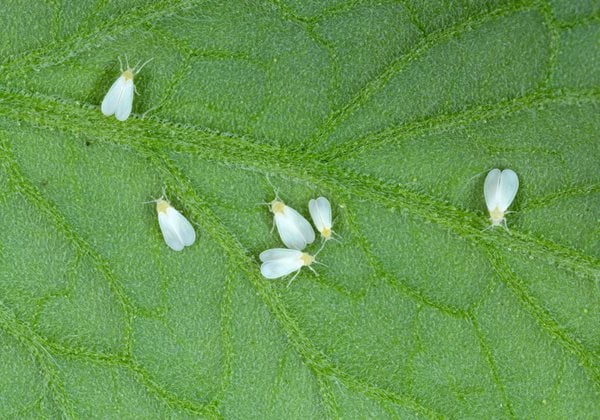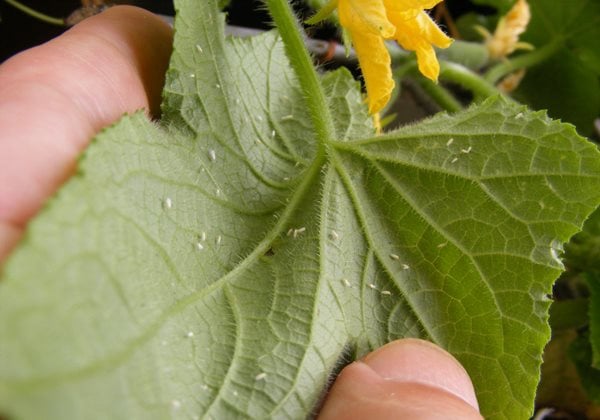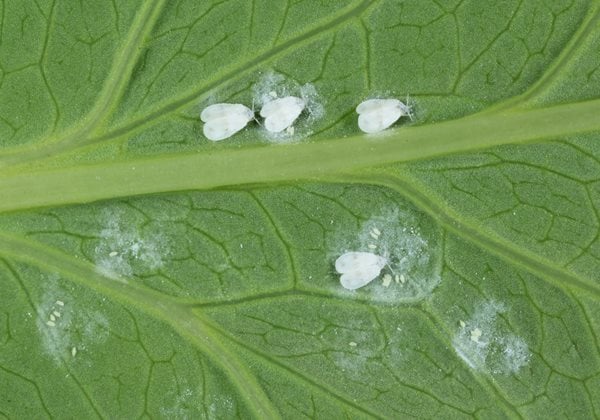HOW TO GET RID OF WHITEFLIES
How to know if you have whiteflies on your plants and what to do about them
Whiteflies. Photo by: Tomasz Klejdysz / Shutterstock
When it comes to pests, whitefly is one of the most common and most damaging to plants. Whitefly populations can explode quickly and cause serious infestations. Once they have taken hold, whiteflies can be tough to eliminate, so it’s important to recognize the early signs of infestation and apply the necessary treatment to get them under control.
On this page: What are Whiteflies? | Get Rid of Whiteflies | Prevent Whiteflies | Recognize Whiteflies | Plants Susceptible to Whiteflies | Whiteflies on Houseplants | Types of Whiteflies | Whitefly Lifecycle
On this page:
- WHAT ARE WHITEFLIES?
- HOW TO GET RID OF WHITEFLIES
- PREVENT WHITEFLIES
- RECOGNIZE PRESENCE OF WHITEFLIES
- IDENTIFY WHITEFLY DAMAGE
- PLANTS SUSCEPTIBLE TO WHITEFLIES
- WHITEFLIES ON HOUSEPLANTS
- TYPES OF WHITEFLIES
- LIFECYCLE OF WHITEFLIES
WHAT ARE WHITEFLIES?
Despite its name, whitefly is not a true fly, but is closely related to aphids, mealybugs, and scale. These soft-bodied winged insects feed on plant sap, causing leaf damage and a host of other problems. They are moth-like in appearance, about 1/16th of an inch in length with an elongated, somewhat triangular shape, and are most often gray-white in coloring. Because of their tiny size, they can be hard to spot.
8 TIPS: HOW TO GET RID OF WHITEFLIES
If whiteflies are present, try these tips:
- Spray with water: The first line of defense is to gently spray plants with water to dislodge whitefly eggs and nymphs. Because nymphs don’t move after the initial creeping phase, they will starve and die when removed from their food source.
- Keep leaves clean: To control honeydew and mold, wipe down affected leaves with a damp cloth or spray with water.
- Attract natural predators: Beneficial insects that prey on whiteflies offer natural pest control. These natural enemies include ladybugs, green lacewings, dragonflies and whitefly parasite wasp. Create habitat to attract and support these benefactors and plant flowers to attract hummingbirds, which also feed on whiteflies.
- Use insecticidal soap: For heavier indoor or outdoor infestations, use an insecticidal soap (or make your own by mixing 1 tablespoon of Castile soap with 1 quart of water). The soap coats the eggs, larvae, and adults, suffocating them. Apply in the early morning or evening when temperatures are cooler, and repeat according to instructions if necessary.
- Try horticultural oil: Horticultural oils such as neem oil are also effective. This remedy will kill whiteflies at all life stages and discourage black sooty mold. (Read more on how to use neem oil.)
- Use yellow sticky traps: For indoor or outdoor infestations, yellow sticky traps can detect and control pests. Whiteflies are attracted to the yellow color and become stuck to the glue-like substance. This remedy also works for other pests including aphids, fungus gnats, and thrips.
- Use reflective mulch: Cover the ground around susceptible plants such as tomatoes and peppers with metallic fabric mulch. The reflective material is confusing to them, so they will avoid the area.
- Keep it organic: Whiteflies have become resistant to most common pesticides, rendering them ineffective. Organic methods are the most effective and safest for the environment.
You can also make your own by coating yellow index cards on one side with petroleum jelly and set them near your plants. While not as effective as store-bought traps, they can catch some and alert you to their presence.
HOW TO PREVENT WHITEFLIES
The most effective tool to controlling whitefly is prevention.
Keep plants healthy:
Healthy plants are more able to ward off pests and diseases.
Inspect new plants:
Carefully inspect newly purchased plants before bringing them home from the nursery to prevent spreading pests to other plants.
Check plants regularly:
While doing regular gardening chores such as watering and fertilizing, make it part of your routine to inspect plants weekly to detect problems early on. Focus on plants that are most susceptible.
HOW TO RECOGNIZE THE PRESENCE OF WHITEFLIES

Photo by: ULD / Shutterstock
Take a closer look:
Look for insects or eggs on the backside of leaves.
Know what to watch for:
Watch for swarms of tiny bugs that fly off plants when you approach.
Know the signs:
Check for the presence of black sooty mold or ants, which are attracted to the sweet honeydew substance that whiteflies secrete.
IDENTIFY WHITEFLY DAMAGE
Whiteflies are similar to aphids in the kind of damage they cause. Both have piercing-sucking mouthparts that they use to extract plant sap, causing foliage damage and stunted growth. They secrete a sticky substance known as honeydew, which promotes fungal diseases such as black sooty mold.
If left untreated, a whitefly infestation can cause more severe problems. Leaves turn pale or yellow and wilt, eventually dying and falling off. As leaves drop, plants are unable to perform photosynthesis and become further weakened. Whiteflies can also transmit harmful plant viruses, and in extreme cases, cause plant death.
PLANTS SUSCEPTIBLE TO WHITEFLIES
Food crops most affected include beans, brassicas, citrus, cucumber, eggplant, grape, okra, peppers, potatoes, squash, and tomatoes.
Greenhouse-grown and ornamental plants most at risk include hibiscus, poinsettia, roses and bedding plants such as begonia, fuchsia, petunia, and salvia.
WHITEFLIES ON HOUSEPLANTS
Whiteflies will feed on most common houseplants, but prefer varieties with smooth soft leaves, which are easier to pierce with their mouthparts. Take these precautions to protect your indoor plants:
Quarantine:
Keep new houseplants away from other plants for 2 to 3 weeks, which should be enough time to detect the presence of whiteflies or other pests.
Vacuum bugs away:
Use a small handheld vacuum cleaner or hose attachment to gently remove adult whiteflies, larvae, and eggs, taking care not to damage plants. Dispose of the vacuum bag in an outdoor trash bin.
Use sticky traps:
Place yellow sticky ribbon, stakes, or traps near infested plants, following label instructions.
Insceticidal soap:
Use a commercial or homemade remedy (see recipe above) to control population growth.
Neem oil:
If applying neem oil, take care not to get the oil on clothing, furniture, or other household items.
TYPES OF WHITEFLY
There are hundreds of different species, with most having a preferred food source. Until recently, greenhouse whitefly (Trialeurodes vaporariorum), which typically spends its entire life cycle indoors, was the most commonly found species. Other common types include bandedwinged whitefly, citrus whitefly, and giant whitefly. Cabbage whitefly attacks brassicas such as cabbage, cauliflower, and broccoli. Silverleaf whitefly was named for its ability to transform squash foliage into a silvery color when infested.
LIFECYCLE OF WHITEFLIES

Photo by: Tomasz Klejdysz / Shutterstock.
Outdoors, whiteflies begin reproducing in late spring, laying their eggs in a circular pattern on the underside of leaves. In 5 to 10 days the eggs hatch into nymphs, which briefly crawl around until they find a suitable spot to feed. They remain in one place through several more developmental stages until becoming winged, egg-laying adults, with the complete lifecycle taking 2 1/2 to 5 weeks.
Adults can survive for 1 to 2 months, reproducing more quickly during warmer weather and slowing down when the weather becomes colder. Several generations can overlap.
Since whiteflies are unable to survive year-round in USDA zone 7 or colder, they are most often found on indoor houseplants or in greenhouse environments in northern regions. In warmer areas, whitefly larvae can survive outdoors through winter. Outdoor plants that come from an infested greenhouse can spread these pests to other plants in your landscape during warmer months.
RELATED:
How to Get Rid of Aphids Naturally
Getting Rid of Japanese Beetles
How to Get Rid of Grub Worms
Tomato Diseases, Pests & Problems
